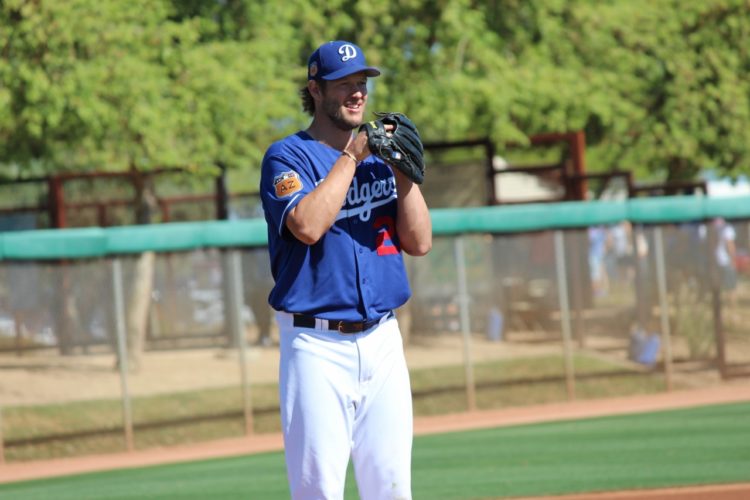
| IP | K% | BB% | HR/9 | ERA | FIP | xFIP | WAR | |
| MLB | 175 | 29.8 | 4.4 | 1.18 | 2.31 | 3.07 | 2.84 | 4.6 |
What Happened In 2017: Had yet another outstanding season, though injuries stood in the way of a fourth Cy Young Award.
——
In 2017, Clayton Kershaw took a bit of a step back from his previous year’s performance, but Kershaw’s version of taking a step back still led to some truly superb results. For the fifth time in his career, Kershaw led the National League in ERA; he also posted the NL’s best ERA+ (180).
So what was different about last season? For one, Kershaw’s walk rate doubled from 2016 to 2017. Normally, that’s something that would be massively troubling for a pitcher. In Kershaw’s case, that meant going from two percent to four percent. It’s hard to have any kind of serious concern about that. On the other side of the K/BB coin, Kershaw’s strikeout rate was a bit down from the prior year, sinking below 30 percent for the first time since 2013. Yet Kershaw was still third in the NL in strikeout percentage, and fifth in all of baseball.
A more legitimate potential cause for concern was the spike in home runs Kershaw allowed, a career-high 23. For the first time in his ten MLB seasons, Kershaw’s HR/9 exceeded 1.00. For the first time in his career, he allowed four home runs in one game (once in the regular season, once in the postseason). An increase in homers allowed was a league-wide problem, hardly limited to Kershaw, and the fact that he managed to lead the NL in ERA in spite of this struggle is pretty remarkable. Still, the home run ball will be something to watch out for with Kershaw next season.
Regardless of any of that, Kershaw was great far more often than not last year. Among his highlights was a 14-strikeout game against the Brewers in June, during which he recorded his 2,000th career K.
There was also his one complete game of the season, on July 2, in which he held the Royals to one run while striking out 13.
(It should be noted that Kershaw pitched nine innings against the Cardinals on May 23, but gave up the tying run in the ninth inning; the Dodgers ultimately won in 13.)
In late July, Kershaw hit the disabled list with a lower back strain. Back issues are now a recurring problem for Kershaw, who missed two months in 2016 with mild disc herniation. This time, he missed nearly six weeks of action; the Dodgers were without his services for all of August.
When Kershaw came back on Sept. 1, the Dodgers had lost five games in a row, on their way to losing 16 of 17. Kershaw kept it from being a 17-game losing streak with an excellent six-inning, no-run outing against the Padres. Once it became clear the Dodgers weren’t going to blow their divisional lead in historic fashion, the rest of the month served as an opportunity for Kershaw to tune up for the postseason.
This year’s playoffs were a mixed bag for Kershaw, as he alternated between excellent and not-so-excellent. Game 1 of the NL Division Series qualified as the latter, as Kershaw allowed four home runs in 6.1 innings pitched. Fortunately, they were all solo home runs, and the Dodgers went on to beat the Diamondbacks, 9-5. The Dodgers would sweep that series, so the issue of Kershaw pitching on short rest did not get the chance to rear its ugly head this time around.
After pitching sufficiently well in Game 1 of the NL Championship Series against the Cubs, Kershaw got the ball again in Game 5. For a brief moment, it was the biggest game of Kershaw’s career. He rose to the occasion with six innings of one-run ball, en route to a victory that sent the Dodgers to their first Fall Classic in 29 years.
Kershaw’s first World Series start was arguably the best of his postseason career. (He has one other that matches it by Game Score [78], Game 1 of the 2016 NLCS, though this was obviously much more significant.) Kershaw allowed one run in seven innings pitched and struck out 11 Astros batters, at the time appearing to set a favorable tone for the Dodgers in the series.
Game 5 was decidedly less brilliant. I don’t want to talk about it, and you don’t want to remember it, so let’s just not.
Then came Game 7. Kershaw entered in relief in the third inning with the Dodgers down 5-0, and he was fantastic, striking out four and allowing no runs — all while pitching on two days’ rest.
Had the Dodgers managed to come back, his performance would be something we talked about for years to come. But they didn’t, and his efforts ended up not meaning a thing. Baseball’s cruel like that sometimes.
Because of time missed due to injury, Kershaw registered only 175 innings pitched during the regular season. Even so, he finished second in Cy Young Award voting. That makes it seven straight seasons of Kershaw finishing in the top five of voting for the prize.
——
2018 Status: Heading into the fifth year of his seven-year contract, after which he can (and likely will) opt out. God help us.
 Dodgers Digest Los Angeles Dodgers Baseball Blog
Dodgers Digest Los Angeles Dodgers Baseball Blog